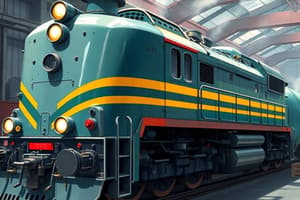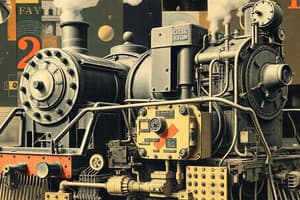Podcast
Questions and Answers
What is a critical design consideration for diesel locomotives regarding their operational capabilities?
What is a critical design consideration for diesel locomotives regarding their operational capabilities?
- Power and torque characteristics of the engine (correct)
- The color scheme of the locomotive
- Type of braking system used
- Length of the locomotive
Why is regular maintenance vital for diesel locomotives?
Why is regular maintenance vital for diesel locomotives?
- It lowers the initial construction cost
- It improves the aesthetic appearance of the locomotives
- It ensures smooth operation and durability (correct)
- It increases fuel consumption efficiency
In which application are diesel locomotives predominantly used?
In which application are diesel locomotives predominantly used?
- Freight trains (correct)
- Speed racing
- Luxury cruise trains
- High-speed monorails
What future trend is being pursued in the design of diesel locomotives?
What future trend is being pursued in the design of diesel locomotives?
What role does preventive maintenance play in the lifespan of diesel locomotives?
What role does preventive maintenance play in the lifespan of diesel locomotives?
What is the primary advantage of diesel engines over gasoline engines?
What is the primary advantage of diesel engines over gasoline engines?
Which component of a diesel electric locomotive converts mechanical power into electrical power?
Which component of a diesel electric locomotive converts mechanical power into electrical power?
What is a disadvantage of diesel locomotives compared to electric locomotives?
What is a disadvantage of diesel locomotives compared to electric locomotives?
Which type of diesel locomotive uses a diesel engine directly connected to the driving axles?
Which type of diesel locomotive uses a diesel engine directly connected to the driving axles?
What is one key characteristic of diesel electric locomotives?
What is one key characteristic of diesel electric locomotives?
What aspect of diesel engines contributes to their improved efficiency compared to steam locomotives?
What aspect of diesel engines contributes to their improved efficiency compared to steam locomotives?
Which of the following is NOT an advantage of diesel locomotives?
Which of the following is NOT an advantage of diesel locomotives?
What kind of power delivery does a diesel electric locomotive offer compared to diesel mechanical locomotives?
What kind of power delivery does a diesel electric locomotive offer compared to diesel mechanical locomotives?
Flashcards
What powers a diesel locomotive?
What powers a diesel locomotive?
A diesel locomotive is powered by a diesel engine, which acts as the primary source of power.
How do diesel electric locomotives work?
How do diesel electric locomotives work?
Diesel electric locomotives use a diesel engine to power a generator that produces electricity to drive electric motors.
How does a diesel engine ignite fuel?
How does a diesel engine ignite fuel?
Unlike gasoline engines that use spark plugs, diesel engines ignite fuel by compressing air in the cylinders to very high temperatures and pressures, which spontaneously ignites the injected fuel.
What is a Diesel-Electric Locomotive?
What is a Diesel-Electric Locomotive?
Signup and view all the flashcards
What are the main components of a Diesel Electric Locomotive?
What are the main components of a Diesel Electric Locomotive?
Signup and view all the flashcards
What are the advantages of diesel locomotives?
What are the advantages of diesel locomotives?
Signup and view all the flashcards
What are some disadvantages of diesel locomotives?
What are some disadvantages of diesel locomotives?
Signup and view all the flashcards
Locomotive Design: Hauling Capacity
Locomotive Design: Hauling Capacity
Signup and view all the flashcards
Locomotive Design: Material Strength
Locomotive Design: Material Strength
Signup and view all the flashcards
Diesel Locomotive Maintenance: Regular Inspections
Diesel Locomotive Maintenance: Regular Inspections
Signup and view all the flashcards
Diesel Locomotive Maintenance: Preventive Measures
Diesel Locomotive Maintenance: Preventive Measures
Signup and view all the flashcards
Future Trends: Diesel Locomotive Emissions
Future Trends: Diesel Locomotive Emissions
Signup and view all the flashcards
Study Notes
Diesel Locomotive Overview
- Diesel locomotives are powered by diesel engines, which provide the prime mover to drive the locomotive.
- These engines are typically more fuel efficient than steam locomotives.
- Diesel electric locomotives are the most common type, utilizing a diesel engine to power a generator that produces electricity to drive electric motors.
- This configuration offers greater flexibility and efficiency compared to diesel mechanical locomotives.
Diesel Engine Principles
- Diesel engines combust fuel directly in cylinders, unlike gasoline engines which use spark ignition.
- The compression of air in the cylinders to extremely high pressures ignites fuel injected at a precise moment.
- This process happens naturally in the internal combustion process without needing a spark.
- Fuel efficiency and power are key advantages of the diesel engine compared to gasoline engines.
Types of Diesel Locomotives
- Diesel electric locomotives (most common): Power from a diesel engine is transformed to electric power, which in turn drives traction motors allowing for greater flexibility in power delivery.
- Diesel mechanical locomotives: Use a diesel engine directly connected to the driving axles, often with less complex auxiliary equipment.
- Hybrid diesel-electric locomotives: Sometimes feature both diesel and electric components in their design.
Components of a Diesel Electric Locomotive
- Diesel Engine: The primary power source, providing mechanical power.
- Alternator (generator): Converts the mechanical power into electrical power.
- Transformers: Step up or step down the electrical current.
- Power Distribution System: Distributes power from the alternator to the traction motors.
- Traction Motors: Convert electrical power into mechanical power to drive the axles.
Advantages of Diesel Locomotives
- Higher fuel efficiency than steam locomotives.
- Lower maintenance costs in many cases, especially when considering the complexity of steam locomotives.
- Increased speed and acceleration compared to steam power; better capabilities in varying terrain.
- Versatility in operation modes that accommodate different trains.
- Greater maneuverability on shorter lines.
Disadvantages of Diesel Locomotives
- Higher initial costs compared to electric locomotives which are often more substantial.
- Potentially more noise pollution than other types of locomotives.
- Emission of harmful exhaust gases.
- Can be less efficient in very high-power needs.
Locomotive Design Considerations
- Power and torque characteristics of the engine need to be considered for expected hauling capabilities.
- The design needs to accommodate the weight and type of loads (trains) it will carry.
- Materials used in the construction must be strong to withstand large forces during operation.
Maintenance of Diesel Locomotives
- Regular maintenance is essential to ensure smooth operation and durability.
- Inspections at regular intervals are key to prevent potential mechanical failures.
- Preventive maintenance, including component replacement and repair, is crucial to extend the lifespan.
Applications of Diesel Locomotives
- Freight trains: Diesel locomotives are heavily used for hauling freight.
- Passenger trains: Some passenger train systems employ diesel locomotives.
Future Trends
- Continuous improvements in the design and engineering of diesel engines are aiming to reduce emissions.
- Development of alternative fuels, and hybrid options, for diesel locomotives are being explored.
- Increased automation and use of advanced control systems are common upgrades for newer locomotives.
Studying That Suits You
Use AI to generate personalized quizzes and flashcards to suit your learning preferences.
Description
Explore the fundamentals of diesel locomotives, including how they are powered by diesel engines and their efficiency compared to steam locomotives. This quiz covers the differences between diesel electric and diesel mechanical locomotives, as well as the principles of diesel engine operation.




